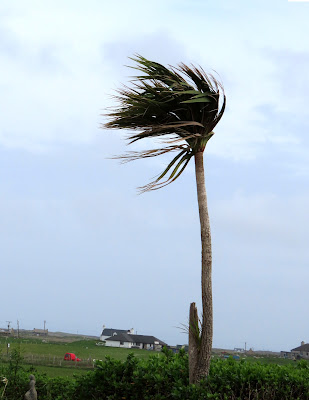Coot Loch
Monday May 2
Whilst I finished reading my book, Pam had a busy morning helping Heather herd a Houdini Muscovy Duck back into her pen. Twice. Despite watching her, no-one has been able to fathom how she gets out. Fiona's sheepdog tries to help - but she's frightened of the duck. I then had a welcome phone call from daughter Sara.
Eventually, we set off, intercepted by Heather bearing a bag of four biscuits she'd knocked up in between duck herding. Very nice too. We were looking for Coot Loch. I knew that it was in Benbecula, like many birding places named by birders, it's not on the maps, nor on the internet. A gift shop owner made a phone call and we were on our way. Past Stinky Bay - another name not mapped - where there were about 30 Eider ducks - and then a detour to the Phalarope loch. There we had a Shoveller
a very dark Common Redshank
and a Wigeon. A Little Egret on roadside water was a Hebridean tick.
Coot Loch was on the left along the same coast road. And yes, there were several Coot. No sign of the Garganey seen yesterday evening, but Red Breasted Merganser, Tufted Ducks, Little Grebe, Grey Heron and Mallard.
A mid afternoon lunch was eaten lochside on the track to Flodda, watching a grab loading seaweed into the back of lorries. Men piled up the weed using forks, the grab lifted it into the lorry where a man waited to spread the weed - and jump up and down to flatten it. All very entertaining.
Heather tells us that the seaweed is dried and powdered before being given free to the farmers.
Pam wanted to photograph the rams, we drove as far as the field which held the Hebridean sheep and their well grown lambs first. One little fellow was trying to take the grass out of its mother's mouth as she chewed it. She was not happy.
We could not pass Committee Road. Very soon, a male Hen Harrier appeared on our right, flying across the front of the car, before rapidly disappearing across the hillside. My first, but Pam had a male fly over the apartment this morning. Always a joy. They are still digging for peat here. Lines of dug turves, looking machine hewn rather than by hand,
One peat heap, the rest tied up in bags scattered across the land. Surely this practice is no longer necessary.
Pam put out the Emperor moth lure - it's an impregnated cork - seconds later, a male appeared, fluttering madly around before deciding that a cork wasn't much fun.
We went home to photograph the overnight trap catch of a meagre four moths, all different. The best was a female Emperor Moth which had laid a clutch of eggs on an egg box. We shall try and hatch them.










Comments
Post a Comment